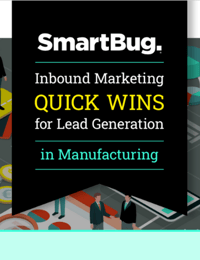
As manufacturers seek to attract buyers in more efficient and scalable ways the need for search engine optimized content is more pronounced than before. Buyers often research online, even before talking to a manufacturer representative, and the content that lands on their computers has a significant impact on their final purchase decisions.
Manufacturers need their websites, content, and product offerings to be found online through internet searches. Whether it has a B2B, B2C, or even B2G (government) business model, a manufacturer with a forward outlook strives to rank high in search results, such as on Google, Bing, or Yahoo!
What should you do to optimize your company for SEO? There are a few strategies and tactics you can implement to boost rankings, traffic, and generate leads for future business:
1. Ensure that Your Technical SEO House Is in Order
Before thinking about what people are searching for, it’s imperative that your website can be found, is trusted by both search engines and users, and creates a great user experience. Take a look at the following:
- Page speed: Does your website have too many large images or videos? Is there unnecessary code on your website? These and other factors can slow down your page loading time and can result in users leaving before engaging with your content. You can get a free website grade or look at your Google PageSpeed Insights report.
- SSL certificates: Have you noticed “http” or “https” at the beginning of URLs? The “s” at the end of the latter tells web servers, browsers, and users that your website is secure. This Secure Sockets Layer (SSL) certificate means the connection between the web server and browser is encrypted and the data is private. When ranking webpages, Google factors whether or not the page has an SSL certificate. Having a secure website also sends the right message to your user: Your company cares about security and is up to date on the latest and greatest web standards.
- Metadata: This is information about the page. Two common pieces of metadata are the meta title, which is the title of the page that shows up in your browser tab and at the top of the search engine results listing, and the meta description, which is the description of the content on the page, which should be kept to 160 or fewer characters.
The top red box contains the meta title; the second box contains the meta description.
- Index and follow: “Indexing” data tells search engines whether they should crawl and list your webpage for future search retrieval. “Follow” tells search engines to follow the links on your page to other pages. There are “index/noindex” and “follow/nofollow” choices. These types of settings can ensure that content you don’t want to be found on the web (such as certain PDFs) are not publicly accessible but can still be found after a chosen conversion path.
- Errors and mobile experience: When reviewing your website through Google Search Console, you want to ensure that all of the 300, 400, and 500 category errors are resolved. These error codes can be fixed with redirects, page updates/removals, or other page or server modifications. In Google Search Console, ensure your pages are formatted with Google Accelerated Mobile Pages (AMP) specific features.
2. Local or National SEO
Now that your house is in order, it’s time to determine who you want to target for your content. A general breakdown is: a local or a national audience. The content on your website should reflect the delineation.
- Local SEO: If you work for a manufacturing facility (such as a steel manufacturer) that can only supply products to certain areas or has predetermined boundaries defining which leads you can convert to customers, a local strategy is recommended. Create a Google My Business account and have targeted keywords for the regions and towns that you can service.
You can also explore other local SEO tools to manage directory listings in bulk. For example, with Moz Local, you can update your information in one place and have that information disseminated to several different directory listings, such as Google My Business, Yelp, and Facebook. - National SEO: For the majority of manufacturers and industrial companies that can ship their products nationwide or have multiple distribution facilities, a broader content and keyword strategy is recommended to capture the larger audience segment.
3. Content that Is Searchable and Solves a Pain Point
Write content that will generate new traffic and increase your rankings within the search engines over time. Prepare to be patient. Launching a new blog post won’t take you to the top of the search results overnight, but a deliberate and consistent strategy and execution will eventually get you there.
- Determine whether you’re targeting other businesses or consumers: As you think about who you sell to for your different product lines, determine whether you are a manufacturer that sells to the end customer, resellers, other businesses, government agencies, or something else. When creating searchable SEO content, you can’t be everything to everyone. Knowing your audience and following their behavior patterns on your website will help you deliver content that speaks directly to their pain points and why they may need your products.
- Create content for your buyer personas: A manufacturer may have several personas, such as a technical expert, a procurement manager who owns the Request for Proposal (RFP) process, or a small business owner whose company adds value to your product before reselling. These different personas will help determine the content that should be produced, the level of technical writing needed, and identify specific pain points that you should demonstrate your product can address.
- Create content for your visitors’ search intent: To produce unique and valuable content, know the pain points of the visitors that influence their search intent. Search engines use an algorithm to deduce what the user wants to read (i.e., their search intent) and to place relevant content at the top of the search results. Is the reader looking for examples of how the product has been used? Are they looking for technical specs of the product? Are they looking for how the problem will save them time, money, and how the products will integrate within their product line? Answer questions like these to figure out what sort of content you should develop for your audience.
- Don’t be afraid to go deep into a topic: Visitors to your website are seeking to learn something, and you have the opportunity to showcase your expertise. Manufacturers who understand the value of inbound marketing focus on attracting traffic with content that solves pain points, and then provide readers additional content that continues their research.
Allow your content to go incredibly deep into a topic. This showcases your expertise and mastery of the subject, building trust with the web visitor. If you’re looking to build out content, do a simple Google search of a keyword and look at the related search topics. This provides amazing insight into the related questions and queries that people have. - Create content to answer questions your prospects are asking: If you’ve done the hard work of getting a prospect to request a quote or talk to a salesperson, they will ask questions to ensure they have all the information needed to proceed. Capitalize on this intel by answering those same questions in future blogs and other content. It’s likely that others are asking the same questions on search engines.
- Provide technical specifications: If your products are rated for certain metrics, meet (or exceed) industry standards, or have been independently tested, post the technical aspects of those metrics on your website, because a buyer may be looking to ensure your products can meet their project or scope needs.
- Showcase how your products were used: If you’re in the middle of the supply chain or you have raw materials used to create a finished product, showcase how those products were used in real-life settings. Whether through a case study or photographic examples on the product pages themselves, painting the picture in the visitor’s mind of how the product can be used will help facilitate further engagement.
- Link within your website: Create content that guides the reader along a journey, whether by directing them to another page that provides product specifications, linking to other pieces of content on the same topic (such as in a topic cluster), or even driving them to a landing page for downloadable premium content. Internal links from one page to another can provide users with actionable next steps, as well as inform search engine spiders about the depth of your website.
- Earn links from external sources: Produce content so rich, valuable, and informative that other websites (e.g., industry publications, your suppliers, your customers) want to link their content to yours. Although not all external links are created equal (there are bad links you may want to disavow), quality links to your site will help improve rankings and overall SEO. You may even consider directly asking colleagues at other organizations to link to your content.
- Create an editorial calendar for content: If you’re getting into the SEO game and trying to rank at the top of search results, creating an editorial calendar is a crucial part of the strategy for long-term success. It’s common for manufacturers to throw in the towel after 3-4 pieces of content don’t show immediate results. But SEO strategy is more like running a marathon than a sprint. Plan out your content, its cadence, and understand that rewards may take time to come through.
4. Target Industry-Specific Keywords
Make sure to do a thorough keyword research analysis as part of the editorial planning process. This research will help you uncover new topics, related pieces of content around a specific theme, and ensure content burnout does not occur.
Content is king, and targeted content is the emperor.
- Keyword analysis: The best searchable content focuses on a specific topic and keyword. There are varying levels of scoring or ranking of specific keywords, as well as search volume attributed to individual keywords or phrases. Creating a plan where you target both high-volume, high-difficulty keywords, as well as low-volume, low-difficulty keywords, will ensure you have a balanced long-term approach. You should also explore what your competitors are ranking for, and utilize that data as you put together your target keyword list.
- Target niche keywords: Keyword research is often bucketed into short-tail keywords and long-tail keywords. These short-tail keywords are often high in volume and scoring difficulty, whereas the niche, long-tail keywords may produce lower volume of total search traffic but directly align with what the visitor is searching for. Visitors that come through long-tail keyword searches are often of higher value, because they are looking for a detailed answer to their detailed question.
- Target industry-specific terms: When conducting keyword research, look at the other phrases users are searching for and other similar search phrases. Combining your findings with industry-specific terms (and analysis of what people are currently searching to land on your website) may highlight the need to create content around industry-specific terms and keywords. Working those industry-specific keywords and topics into your content—and showing how your products align or how your company helped create the industry standards—will weed out many low-value visitors who bounce as soon as they land on your content.
Search engine optimization and getting your content highly ranked on search engine result pages is a long-term effort that requires a deliberate strategy and implementation. The results won’t occur overnight, but sticking to the strategy will result in long-term success for your manufacturing or industrial company.
About the author
Stephen Lackey was formerly SmartBug's VP of Marketing and he is based out of Charlotte, NC. His background is hyper-focused on marketing and sales enablement, working at Fortune 500 companies, startups, and other industry disruptors. His marketing degree is paired with an MBA where Stephen seeks to uncover the 'why behind the why' within marketing data to drive top line revenue. Read more articles by Stephen Lackey.










